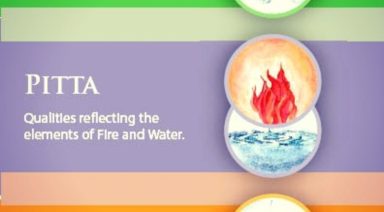What is Satya?

Yoga is an eight-limbed path. The path if followed in order to develop discriminative knowledge as a means to freedom. Attention is the tool for developing the discernment required to walk the path. The Yamas are the first limb of this path and they mean observances and self-regulation in relationship to the external world and others.
Satya is the second of the Yamas, following Ahimsa. Satya means truthfulness and Ahimsa means non-harm. Therefore, to become discerning through attention you must first practice living non-harm and then living truthfully. In this article we explore attuning to truthfulness and other Yamas in daily practice.
When applying Satya to your own life, be gentle with yourself and others and be careful not to be too literal. The truth for truth’s sake, for example, is not more important than maintaining a kind, nonviolent attitude and demeanor. If your truth is simply to reveal something painful but will have no social benefit, it may in fact not be the true meaning of Satya to express it. We will look closer at how to live more consciously of Satya in daily life with the practices below. Be encouraged to live a life more full of your truth as your dive deeper into the theme of Satya.
10 Practices to Living in Satya
Explore Your Current Feeling for Loved Ones
The Satya of relationships: Be encouraged to know how you currently feel in relationships that are longstanding. Scroll through you favorite contacts in your cell phone. Of those names, how many of the people have been important to you for many years? Are you living on an assumption you know how you still feel about them? Make time and space to comfortably lay back and relax. Breathe slowly and let yourself become calm. Then, bring each of these people into your minds eye one at a time. As you do, feel how your body responds to each one. The body gives so much information, the heart, the gut, the throat, and the head. Become aware of the sensation you experience for each important person to you. Enjoy your newfound exploration of these relationships.
Communicate and Don’t Make Assumptions
Do you ever make assumptions without directly communicating about them? Notice how speculation and anticipation shape your reality and keep you from truly communicating with others. The story you create can stand in the way of you opening to truthful conversation.
When you make assumptions you cheat relationships out of being a place you go to communicate and as a result, you live in a false reality.
Will you venture to have open conversations and enter into real communication and depth of relationship?
When Making Big Life Choices, Check In with Your Inner Experience
So often people make choices that they assume others want them to make or that they are “supposed” to make. I gained insight when my friend described her process for deciding whether to get her masters or to follow a healing path. She sat down in meditation and imagined her life going in either trajectory. She said when she thought about school, she could feel her brain. Conversely when she thought about healing arts and continuing on a yoga path, she felt her throat and heart. She said her throat chakra, the seat of her voice, and her heart chakra, the seat of her love were what she cared to feel and that it helped her know which path to follow. Will you make a practice of sitting with big decisions to feel how your mind and body perceive them and choose from your inner truth? What part of you speaks?
Do You Always Say Never?
Become aware of your use of hyperbolic, exaggerated language. If you speak using extremes of language such as always, never, very, so, extremely, all the time, etc., notice this linguistic habit. When it comes up, as yourself if your language use is impeccable or if you are exaggerating. Is this a truthful expression of reality?
Don’t sacrifice kindness for the sake on honesty
If you think too literally about Satya or truthfulness, then you could easily justify saying something just because it’s true. But, what if your speech results in no improvements and only adds hurt? Recall that Ahimsa comes first before Satya, and therefore nonviolent communication is more urgent than truthful communication. Next time you just want to spew negativity, stop!
Notice Your Limiting Beliefs About Yourself
Take this moment as an opportunity to examine living truth of thought and action. How are your limiting beliefs stopping you from reaching your potential? For example, if you just assume you can’t dance because someone made fun of your dance when you were 12, you may never feel the freedom of ecstatic self-expression. If you assume you can’t learn languages because you failed to pick up Spanish while sitting at a desk in college and labeled yourself ‘not good at languages,’ you could be cheating yourself out on an enriching life experience, travel, and relationships with people that speak another language.
With the determination and dedication, most of us can accomplish more than we could ever imagine.
I know this is true because everything I have been doing for years with diligence, I now do with grace and ease where I once felt like a total dud. Check in with your limiting beliefs and see how they may be robbing you of living a truly amazing life, keeping you in a life that isn’t truly yours or preventing you from blossoming into a new you.
The Cycle of Desire
Define your truth through the cycle of desire and notice where you lie to yourself or others, or prevent your own joy because the truth is uncomfortable or untimely. Here are the steps:
The Desire Cycle
- Name the desire and how it makes you feel
- Express your desire
- Be present to receive said desire
- Be grateful for receiving
- Express your gratitude
It can be terrifying to admit what you want even to yourself. Maybe others have expectations of you that you feel pressure to uphold or you’re too afraid to be yourself because you could fail or be rejected. How will you act at this crossroads? Will you be brave enough to admit to yourself what you want? And when you do, will name it aloud to begin manifest it?
Maybe you’ve experienced getting what you want and still did not feel happy. That’s because you must also be present to receive your desire and then to accept it graciously.
Maybe you finally get the job you’ve been after. You are so convinced that you are not worthy of the job that you can’t enjoy it and your lack of self-esteem keeps you from being graceful, gracious, and expressing gratitude. What mental process needs to take place for you to truly be present to receive your desire? You could reimagine the same scenario by becoming ready to accept your desire and know that you getting it means you are worthy. Therefore you can graciously accept and express gratitude and confidence.
Consider the first stage of the cycle of desire, naming your truth. Can you remember a time that you could not or did not choose to admit to yourself what you truly wanted? How did that feel? Now think of a time you admitted to yourself what you wanted, did you find any liberation in that? Continue to notice how the choices you have made in the past may have been authentic to you or you suppressing your true nature. Then, start to think about what you currently desire. How do you want it to play out? Try out the desire cycle to bring your truth into manifestation today.
Be in Touch with Your Throat Chakra
The sensations in your throat can be your teacher. Pay attention to your throat during moments of difficult communication. Does your throat it tense and squeeze? What about in moments of loving communication? Do your words flow with ease? When you are speaking on a day-to-day basis, pause to notice the sensations of your throat. Feel the energy of it being open and fluid, or closed and protected or somewhere in between. Often the sensation of your throat can be a messenger of your truth to you if you only listen.
Is What I Have to Say an Improvement on Silence?
Just because it’s true doesn’t mean it needs to be said. Before you speak, especially if you’re ‘just venting’ for the sake of venting and not pondering problem-solving solutions, stop! The energy around venting can get you stuck in a cycle of negativity and victimhood. Try to express yourself so in a solution-oriented manner. That way, your truth is an expression of discernment and not purely negative. Consider that venting might cause harm to the person you a complaining about which violates the principals and definition of Ahimsa. Applying the principal of Aparigraha, or non-attachment, could help you to let go of what’s bothering you, find a sense of freedom, and then the inspiration to think of a way forward.
Credit the Source of Your Truth
When I have facilitated a really brilliant training, I am aware that my take on kids yoga is re-mix of the wisdom of my teachers, community, experience and education. I routinely make sure to honor the sources of my inspiration formally in my bibliography and aloud with acknowledgement. You make sure to live conscious of Satya (truthfulness) while not forgetting about Asteya (non-stealing) by practicing acknowledging your sources.
Attention to truthfulness is discernment. Living in this way will provide great freedom. Know that nothing needs to be achieved in this moment now. Attuning yourself to your inner truth and communicating that truth in a non-harmful manner will be a challenge. Luckily for you, as you practice, you have plenty of room for error, mistakes, and experimentation. You have your whole lifetime. What is truth today may be different tomorrow. Having a flexible attitude and gentleness toward yourself and others may make walking the path of Satya and ultimately yoga more accessible and pleasant. Gain the freedom yoga promises as you live life authentically.
How to Live with Purpose: The Eight Paths of Yoga

The word yoga is translated literally as union but there are so many different forms, types and practices in yoga that it can often seem confusing. Although the eight limbs of yoga and the eight paths of yoga sound similar, it’s important to differentiate them.
The eight limbs of yoga is explained in Patanjali’s Yoga Sutras as an eightfold path called ashtanga, which means eight limbs (ashta= eight, anga= limb). These limbs are suggestions for living a life full of purpose and meaning. They act as a compass for self-discipline, integrity, and connecting to the divine within ourselves as well as the world around us. They are: yamas, niyamas, asana, pranayama, pratyahara, dharana, dhyana and Samadhi.
The eight paths or forms of yoga are Hatha, Bhakti, Jnana, Karma, Tantra, Raja, Kriya, and Kundalini.
The eight paths or forms of yoga each incorporate at least one or more of the eight limbs of yoga. All forms are practices to accelerate the process of yoga, or what the Bhagavad Gita refers to as, “the science of creating union between the Individual Consciousness with the Ultimate Consciousness.”
Each yogic path essentially is a set of practices designed for a certain type of practitioner. While Karma yoga uses action and service, Bhakti yoga focuses on love and devotion as means of attaining union. Raja yoga is known as the yoga of concentration and Jnana yoga is the yoga of knowledge.
Different from the branches of yoga, explained in Ashtanga, the eight paths each have a unique history and origination. As a yoga practitioner, you might want to review the origin and meaning of each, try the exercises below and journal or meditate on the answers to determine which form you will choose to explore next. Remember, you can only master so many forms in a lifetime.





































